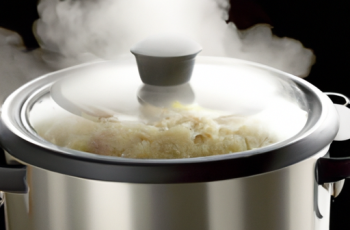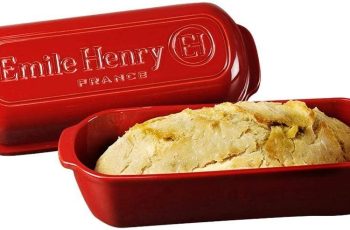Ad Blocker Detected
Our website is made possible by displaying online advertisements to our visitors. Please consider supporting us by disabling your ad blocker.
In the world of cooking, selecting the ideal material for your Dutch oven can significantly impact the outcome of your culinary creations. Cast iron and ceramic are two popular options, each with its unique set of benefits and drawbacks. This article aims to compare and contrast these two materials, enlightening you on the essential factors to consider before making a well-informed decision. Whether you prioritize durability, heat retention, or aesthetic appeal, understanding the characteristics of cast iron and ceramic Dutch ovens will empower you to choose the perfect option for your cooking needs.
Cast Iron Dutch Ovens
1.1 What is a Cast Iron Dutch Oven?
A cast iron Dutch oven is a heavy cooking pot that is made entirely of cast iron. It usually has a thick, flat bottom and high walls to retain heat efficiently. The lid of a cast iron Dutch oven is typically tight-fitting to ensure that moisture and flavors are sealed in during the cooking process.
1.2 Advantages of Cast Iron Dutch Ovens
Cast iron Dutch ovens offer numerous advantages that make them a popular choice among professional and home cooks. Firstly, they have excellent heat retention properties, allowing for even heat distribution and consistent cooking. This makes them ideal for slow cooking, braising, and simmering dishes.
Furthermore, cast iron Dutch ovens are incredibly versatile. They can be used on a stovetop, oven, or even placed directly into a campfire. This versatility allows for a wide range of cooking techniques and recipes to be prepared using a cast iron Dutch oven.
Another advantage is the durability of cast iron Dutch ovens. When properly cared for, they can last for generations. Unlike other cooking materials, cast iron Dutch ovens do not scratch easily and can withstand high heat and heavy use without warping or cracking.
1.3 Disadvantages of Cast Iron Dutch Ovens
While there are many advantages to using a cast iron Dutch oven, there are also a few disadvantages to consider. One of the main drawbacks is their weight. Cast iron Dutch ovens can be quite heavy, especially when filled with food. This can make them difficult to handle, especially for those with limited strength or mobility.
Additionally, cast iron Dutch ovens require proper maintenance to prevent rust. They must be seasoned regularly with oil to create a non-stick surface and protect against corrosion. This maintenance routine can be time-consuming for some individuals.
Lastly, cast iron Dutch ovens tend to be more expensive compared to other materials. However, considering their durability and longevity, it can still be a worthwhile investment for avid cooks.
1.4 Maintenance and Care for Cast Iron Dutch Ovens
To ensure the longevity of your cast iron Dutch oven, proper maintenance and care are crucial. After each use, it is important to clean the Dutch oven thoroughly with hot water and a stiff brush. Avoid using soap, as it can strip away the seasoning that provides the non-stick surface.
After cleaning, dry the Dutch oven completely and apply a thin layer of oil to prevent rust from developing. This process is known as seasoning. Place the Dutch oven in a preheated oven for about an hour to allow the oil to absorb into the cast iron. Repeat this seasoning process periodically to maintain the non-stick surface and protect against rust.
Additionally, never soak a cast iron Dutch oven in water or place it in the dishwasher, as this can cause rust and damage.
1.5 Cooking Performance of Cast Iron Dutch Ovens
The cooking performance of cast iron Dutch ovens is exceptional due to their ability to retain and distribute heat evenly. The thick walls and bottom of the Dutch oven ensure that heat is retained effectively, allowing for slow and even cooking.
The even heat distribution also helps in preventing hot spots, resulting in perfectly cooked dishes. This makes cast iron Dutch ovens ideal for long and slow cooking methods such as braising and stewing. The tight-fitting lid traps moisture and flavors, further enhancing the taste and texture of the dish.
The radiant heat produced by cast iron also gives dishes a beautiful, caramelized crust, adding richness and depth of flavor.
Ceramic Dutch Ovens
2.1 What is a Ceramic Dutch Oven?
A ceramic Dutch oven is a type of cooking pot that is made from ceramic materials such as porcelain or stoneware. It is known for its stylish and elegant appearance, often featuring vibrant colors and intricate designs. Ceramic Dutch ovens usually have a thick-walled, heavy-bottomed construction similar to cast iron Dutch ovens.
2.2 Advantages of Ceramic Dutch Ovens
One of the main advantages of ceramic Dutch ovens is their aesthetic appeal. They are available in various colors and designs, allowing for a personalized and decorative addition to the kitchen. Ceramic Dutch ovens can be used as serving dishes, making them perfect for entertaining guests.
Furthermore, ceramic Dutch ovens offer great heat retention properties, similar to cast iron. They are excellent at holding and distributing heat evenly, ensuring that food cooks thoroughly and consistently. This makes them suitable for a range of cooking methods, including baking, roasting, and braising.
Ceramic Dutch ovens are also non-reactive, meaning they do not interact with acidic or alkaline ingredients. This makes them a safe option for cooking or marinating dishes that contain ingredients like tomatoes or vinegar.
2.3 Disadvantages of Ceramic Dutch Ovens
While ceramic Dutch ovens have many advantages, there are a few disadvantages to consider. One of the main drawbacks is their fragility. Ceramic materials can chip or crack if mishandled or dropped. This makes them less suitable for outdoor or rough cooking environments.
Another disadvantage of ceramic Dutch ovens is that they are not as durable as cast iron. Over time, ceramic may develop hairline cracks or crazing, especially with exposure to rapid temperature changes. However, these cracks do not affect the overall functionality of the Dutch oven.
Additionally, ceramic Dutch ovens may be more expensive compared to other materials due to the craftsmanship and aesthetic appeal.
2.4 Maintenance and Care for Ceramic Dutch Ovens
To properly care for a ceramic Dutch oven, it is essential to handle it with care to avoid chipping or cracking. Avoid sudden temperature changes, such as placing a hot Dutch oven on a cold surface or vice versa, as this may cause thermal shock and potential cracking.
Cleaning a ceramic Dutch oven is relatively simple. After each use, allow the Dutch oven to cool completely before washing it with warm, soapy water and a soft sponge or cloth. This will help remove any food residue or stains. Avoid using abrasive cleaners or scrubbers, as they can damage the ceramic surface.
To prevent staining, it is recommended to season the interior of a ceramic Dutch oven with cooking oil before using it for the first time. This helps create a protective layer, making it easier to clean and maintain.
2.5 Cooking Performance of Ceramic Dutch Ovens
Ceramic Dutch ovens are known for their excellent cooking performance. The thick walls and heavy bottom of the Dutch oven ensure even heat distribution, resulting in consistent and well-cooked dishes.
Due to their excellent heat retention properties, ceramic Dutch ovens are perfect for slow cooking methods such as braising, stewing, and simmering. They also provide a moist cooking environment, which is ideal for creating tender and flavorful dishes.
Ceramic Dutch ovens are particularly well-suited for baking and roasting. The even heat distribution allows for consistent browning and crispness, while the tight-fitting lid helps in trapping moisture and flavors.
Choosing the Right Material
3.1 Factors to Consider
When choosing between a cast iron and a ceramic Dutch oven, there are several factors to consider. Each material has its own advantages and disadvantages, and it ultimately comes down to personal preference and cooking style.
3.2 Purpose of Use
Consider how you plan to use the Dutch oven. Are you primarily looking for a pot to slow cook stews and casseroles? Or do you also want to use it for baking and roasting? Understanding your cooking needs and preferences will help determine the most suitable material.
3.3 Heat Retention and Distribution
Both cast iron and ceramic Dutch ovens offer excellent heat retention and distribution. However, cast iron has slightly better heat retention properties, while ceramic distributes heat more evenly. Consider which aspect is more important to you based on the dishes you enjoy cooking.
3.4 Versatility
Cast iron Dutch ovens are known for their versatility. They can be used on a stovetop, in the oven, or even over a campfire. Ceramic Dutch ovens are also versatile but may have certain limitations due to their fragility. Consider how and where you plan to use the Dutch oven to determine the best material for your needs.
3.5 Durability
Cast iron Dutch ovens are exceptionally durable and can last for generations with proper care. Ceramic Dutch ovens, while not as durable, can still be long-lasting if handled with care. Consider the level of durability you require based on your lifestyle and cooking habits.
3.6 Price
Price is an important consideration when choosing a Dutch oven. Cast iron Dutch ovens tend to be more expensive initially, but their durability and longevity make them a worthy investment. Ceramic Dutch ovens may have a lower upfront cost but may require more frequent replacement if mishandled.
3.7 Cooking Styles
Consider your preferred cooking styles and the recipes you enjoy preparing. Cast iron Dutch ovens are ideal for slow cooking, braising, and simmering, while ceramic Dutch ovens excel in baking and roasting. Understanding your cooking styles will help guide your material choice.
3.8 Aesthetics
If the appearance of your kitchenware matters to you, consider the aesthetics of the Dutch oven. Cast iron Dutch ovens have a classic and rustic look, while ceramic Dutch ovens come in a variety of colors and designs to complement your kitchen decor.
3.9 Weight
Weight is an important factor to consider, especially if you have limited strength or mobility. Cast iron Dutch ovens are significantly heavier than ceramic Dutch ovens, making them more challenging to handle.
3.10 Conclusion
In conclusion, both cast iron and ceramic Dutch ovens have their own unique features and benefits. Cast iron Dutch ovens are known for their exceptional heat retention, versatility, and durability. On the other hand, ceramic Dutch ovens offer aesthetic appeal, great heat distribution, and a safer option for acidic ingredients.
When choosing the right material, consider factors such as purpose of use, heat retention and distribution, versatility, durability, price, cooking styles, aesthetics, and weight. By considering these factors, you can make an informed decision and select the Dutch oven that best suits your cooking needs and preferences.

